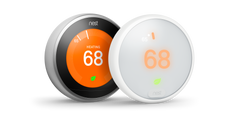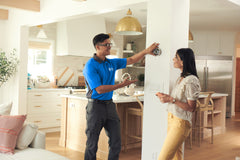
Go Green with Energy Star® Rated Smart Thermostats Offering Certified Savings
According to Kermit the Frog, “it’s not easy being green.” Thanks to smart thermostats, that’s no longer the case.
Almost half of the average American households’ annual energy costs is for heating and cooling related expenses, totaling about $900 per year. That’s a lot of lattes, like about 150 of them from your local Starbucks.
 A certified Energy Star smart thermostat can help homeowner’s save up to 15% on energy costs while keeping homes comfortable at the same time. But not all smart thermostats are created equal. Each device offers innovative ways of improving energy efficiency, so do your research and choose the smart thermostat that's right for your household.
A certified Energy Star smart thermostat can help homeowner’s save up to 15% on energy costs while keeping homes comfortable at the same time. But not all smart thermostats are created equal. Each device offers innovative ways of improving energy efficiency, so do your research and choose the smart thermostat that's right for your household.
Some common smart thermostat features like offered with the Google Nest Learning Thermostat include:
- Remote Control – Adjust the temperature from anywhere using your phone or tablet.
- Proximity Sensors – Detect when the home is empty to set the HVAC system to an energy-efficient temperature.
- Learning Algorithms – Create a schedule that automatically adjusts temperature when you are asleep or away.
- Over-the-Air Updates – Periodically updates software to ensure it uses the latest energy-saving features currently available.
HVAC Compatibility
Always ensure the smart thermostat you select works with your HVAC system. Heating and cooling equipment comes in many forms (heat pump, gas furnace, air conditioner, air handler, etc.) with a variety of features, so your thermostat should be compatible with all of the operational modes of your system:
- If your home has a heat pump, the thermostat should control the auxiliary heat function. If it is specific to a gas furnace, you may not be able to control this feature.
- A two-stage or variable-speed system may only be operating at a single speed because the thermostat does not allow for two-stage wiring.
- A dual-fuel system, which consists of a gas furnace and a heat pump, should be connected to a thermostat that can accommodate the specific heating set points.
 Additionally, if you have a variable-speed or multi-stage system, or a unit that’s zoned for different areas of your home, your professional technician will have to install a smart thermostat that's compatible with these types of systems. For example, the Google Nest Thermostat E will not work with two-stage heat pump units. Of course, if you’re unsure of which type of system is installed in your home, it’s best to ask a professional installer from OnTech for help, or consult an online smart home device compatibility checker.
Additionally, if you have a variable-speed or multi-stage system, or a unit that’s zoned for different areas of your home, your professional technician will have to install a smart thermostat that's compatible with these types of systems. For example, the Google Nest Thermostat E will not work with two-stage heat pump units. Of course, if you’re unsure of which type of system is installed in your home, it’s best to ask a professional installer from OnTech for help, or consult an online smart home device compatibility checker.
Wiring & Voltage
While it’s always best to hire a licensed professional to install your smart thermostat, a basic understanding of wiring and voltage can be helpful. Most smart thermostats have home automation features which require constant power from a ‘common’ C-wire.
The C-wire supplies continuous power to your smart thermostat. If your home’s current setup does not include a dedicated C-wire, you may need the assistance of a licensed professional to add the specific wiring required for your smart thermostat.
Most smart thermostats on the market today require low-voltage wiring (24 volts). These wires are typically very thin, similar to wiring for doorbells or telephone jacks. A low-voltage system is commonly used to connect:
- Conventional gas-forced air furnaces
- Single- or multi-stage heat pumps providing heating and cooling
- Electric central air conditioning systems with forced-air ductwork
 Other thermostats utilize line-voltage, powered directly by a standard 120-volt or 240-volt circuit. These wires are typically thick like those found inside a wall outlet or light switch. These higher voltage systems are primarily used for electric-resistance type heating systems, such as electric baseboard or in-wall heaters.
Other thermostats utilize line-voltage, powered directly by a standard 120-volt or 240-volt circuit. These wires are typically thick like those found inside a wall outlet or light switch. These higher voltage systems are primarily used for electric-resistance type heating systems, such as electric baseboard or in-wall heaters.
The majority of smart thermostats currently available are designed for low-voltage systems, but some offer workarounds for line-voltage applications. However, please consult a professional installer from OnTech to assess your specific home setup if you are unsure.

